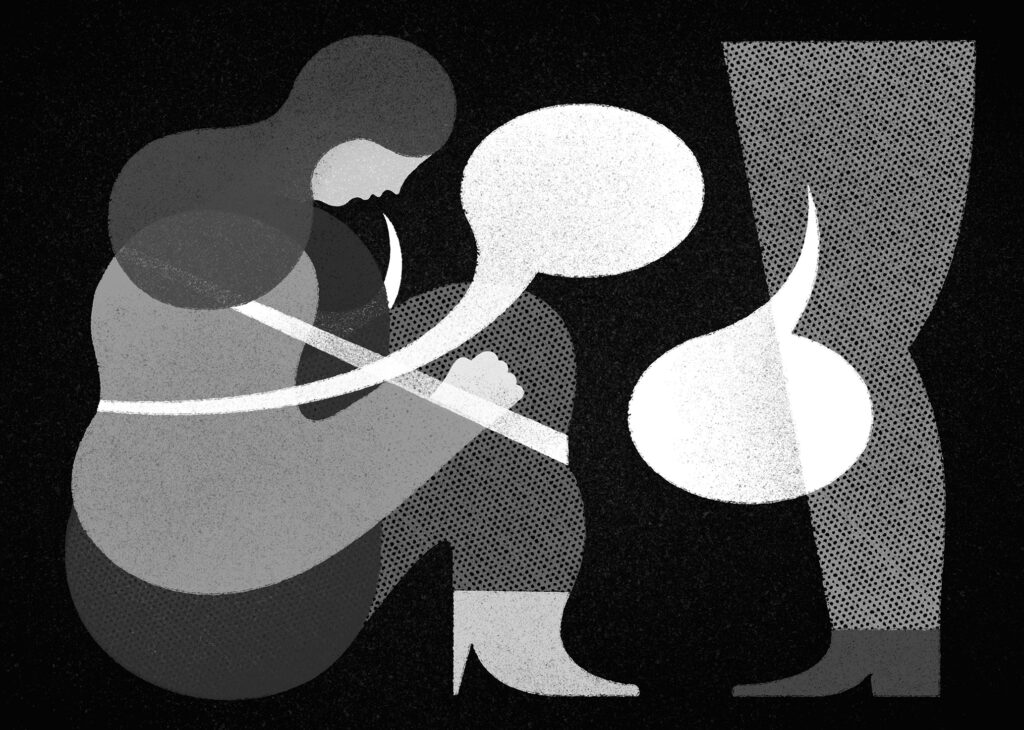In Suing for Silence, Mandi Gray opens up important conversations about sexual violence and defamation law in Canada. Her book is exploratory rather than definitive, making an argument that defamation law is being used to silence victims of sexual violence. Those accused of sexual violence sue the accusers. Even victims who are not sued for defamation may be silenced because they fear being sued. Gray’s evidence is anecdotal, not systematic. She nonetheless raises serious concerns about individuals, usually women, who are subject to lawsuits by those, typically men, accused of wrongdoing.
An assistant professor of criminology at Trent University, in Ontario, Gray makes numerous contributions. She provides a legal guidebook, explaining step by step how civil law works in defamation cases. Her description is augmented by first-person accounts of what it is like to be served with a legal notice. One professor — one of the few men interviewed for the book — admits that when he saw the document, “I allowed myself to laugh loudly.” He was disbelieving but confident that the “completely flimsy case” for defamation had no legal merit; he had spoken out in workplace meetings, supporting female students who had accused a colleague of sexual harassment, manipulation, and coercion. This initial confidence, the professor acknowledges, was misjudged. The realities of the suit soon hit, creating significant financial and emotional stress as legal fees mounted and he began the time-consuming process of preparing a defence.
In many cases, being served is only the beginning of a long, expensive ordeal. We read about the difficulties that individuals, again mostly women, face when they seek legal support to counter defamation claims. One woman describes what it was like for a man to “just sue me for whatever and drag me up and down the courts until I gave up,” even as she was convinced of her innocence and “the fact that I was warning other people for their safety.”

The legal system can devastate those who try to speak up.
Karsten Petrat
This same woman was devastated by a judicial system that did not seem to recognize what Gray characterizes as “a retaliatory attack.” Once, a judge bluntly informed her, “Well you made these statements and you’re going to have to defend that in court.” For Gray, this is a prime example of how women are silenced through defamation suits, their concerns about sexual violence pushed back into the private sphere.
Many routine aspects of the legal process are painful, as various interviewees testify. During the discovery stage, for instance, a defendant’s “medical records, tax records, and education records” can be required by a plaintiff’s legal counsel, to help quantify “the harm between what your life was and what it is now,” as one lawyer explained to Gray. In other words, the defendant’s private life can be laid bare, as the plaintiff’s legal team seeks to portray that person as unreliable, if not unhinged.
Some women decide to file countersuits. Others fear the financial and psychological costs of doing so, especially if it involves having to prove the truth of their allegations in court, which means reliving the violence.
As cases progress, women’s physical and mental health can deteriorate. Gray quotes some who were so physically and emotionally drained that they became suicidal. “I have been in really bad places,” one woman told her. “It is so difficult to get through living and finding a will to live without the added layer of someone trying to tell you [the sexual violence] isn’t real and it’s defamatory and your experience is invalid.”
If defendants agree to mediated settlements to avoid the courts and associated financial and emotional distress, non-disclosure agreements are routine. Gray prefers the term “gag orders,” since they prevent women from talking about their experiences, including in anti-violence activism — yet another form of silencing.
What is the solution? Legislation against “strategic lawsuits against public participation” may appear promising. After all, the purpose of anti-SLAPP laws is to ensure open public debate by protecting participants from legal action when they make statements on matters of interest to the general public. But in practice, Gray writes, anti-SLAPP legislation is too uncertain and too narrow to be effective. She points to the dismissal of an anti-SLAPP case by a judge who observed that those worried about sexual violence could have made a criminal complaint, rather than posting their claims on social media. That judge ignored the fact that the online posts were made by members of the kink community, who were unlikely to feel safe going to the police. Even if a defendant ultimately prevails in an anti-SLAPP case, litigation is onerous and expensive. For these reasons, current legislation is inadequate for protecting those who publicly name perpetrators of sexual violence.
Gray recommends, among other things, better understanding of defamation law in the movement against sexual violence, broad protections for bystanders who report it, and a reduction in legal scenarios “that allow abusive men to sue.” These measures would prevent lawsuits for defamation — or simply the fear of them — from reprivatizing and so silencing discussions about sexual violence.
If Suing for Silence raises important concerns about the use of defamation lawsuits by men accused of sexual violence, it also has notable shortcomings. Robust feminist advocacy requires rigorous reasoning and recognition of the limits of evidence, but Gray appears too committed to her own perspective to contemplate challenges to her conclusions.
Gray usually acknowledges countervailing arguments, but she does not take them up as if they mattered for her own purposes. In particular, she recognizes that men may not always be guilty, but she writes as if they always are. By this logic, a defamation lawsuit is never about an individual who believes he is innocent and seeks to reassert that innocence but is necessarily and always a form of abuse. “Threatening a lawsuit is an extension of an abusive power dynamic,” Gray writes, in a characteristically final judgment.
Gray observes that in anti-SLAPP cases, “defendants who relied on formal reporting mechanisms were more likely to have the lawsuit against them dismissed than defendants who relied on social media.” Nowhere does she suggest that she finds this distinction reasonable, even though formal reporting mechanisms normally allow the accused to have due process while social media is governed by profit-making algorithms that seek more clicks, a poor substitute for meaningful justice. Instead, Gray implies that such attitudes toward social media use represent a barrier, which reflects her understanding that since legal mechanisms are systematically inadequate for victims of sexual violence, which is certainly true, any extra-legal mechanisms for naming perpetrators of violence must be allowable, especially when it comes to the public’s interest in knowing about sexual violence against women.
From this perspective, women should be allowed to name individuals as perpetrators with legal impunity. Otherwise, curtailment of social media use is seen as a grave attack on those who seek to end sexual violence. “I cannot go on Twitter and do #MeToo,” one woman subject to a defamation suit told Gray. “I can’t even talk about it. Kills me.” Her exclusion from social media, Gray explains, has had a profound negative impact on her well-being.
Nowhere, though, is the recognition that a woman’s right to free speech, including about sexual violence, must be balanced against the presumption of innocence and the right of a man accused of sexual violence to a defence. On the contrary, Gray advocates for both victims of sexual violence and sympathetic “bystanders” to have sweeping protections from defamation lawsuits, for any statement relating to such acts.
In other places, claims are stretched too far to be supported by the available facts. Gray presents several cases that suggest that after the #MeToo movement, the news media has been increasingly hit with libel charges when reporting on sexual violence. This trend has made journalists reluctant to feature anonymous testimony, in turn silencing stories about sexual violence. This hypothesis is counterintuitive, in my view, since it suggests that #MeToo led to fewer, not more, stories about sexual violence against women. Certainly any correlation or lack thereof is worthy of further investigation. But Gray writes with finality: “Prior to #MeToo, news outlets regularly allowed people who had experienced sexual violence to remain anonymous in the story. After, the media was far less likely to allow people anonymity.” She describes this effect as “libel chill,” which she claims is “impossible to quantify.”
This is not true. We can ask and answer questions like these: Are there more or fewer news stories about sexual violence since the #MeToo movement began? In those stories, are reporters using more or fewer anonymous witnesses? What do interviews with journalists and legal counsel for news agencies suggest about an increased fear of libel in sexual violence stories? I am not arguing that Gray should have done this research. Rather, she should be direct and clear about the limits of her study, instead of making conclusions that are stronger than the evidence.
Suing for Silence raises critical points about defamation lawsuits against people, mostly women, who publicly discuss sexual violence. A robust feminist analysis that takes up challenging questions — about the presumption of innocence, the right to a defence, the role of social media in naming individuals as perpetrators of violence, and how to encourage public discussion of sexual violence while respecting those rights — is waiting to be written. The merit in Gray’s book is in raising these issues, but, in the aftermath of #MeToo, feminist advocacy will require more rigour to be truly useful to women survivors of sexual violence.
Elaine Coburn is an associate professor of international studies at York University.

